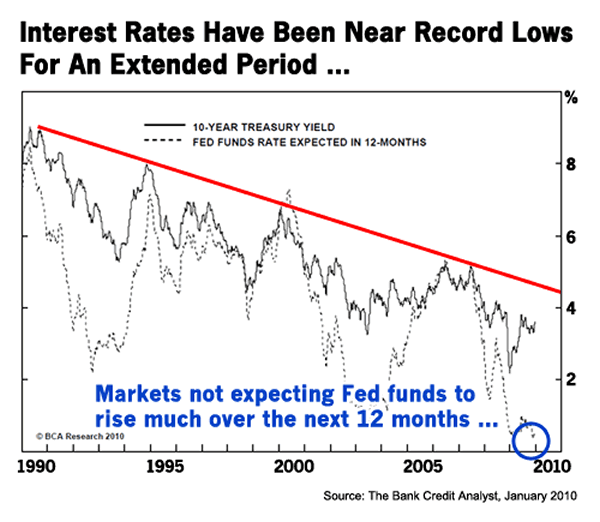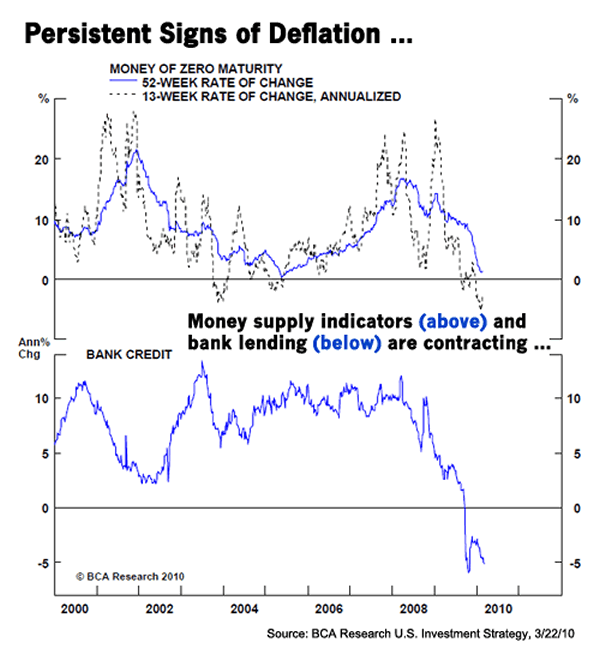Have We Entered A Treasury Bond Bear Market?
Interest-Rates / US Bonds Apr 14, 2010 - 08:19 AM GMT Sharon A. Daniels writes: Bond investors were poised to hit the panic button last week … nervously watching as yields on 10-Year U.S. Treasury bonds briefly pierced the 4 percent level for the first time in well over a year.
Sharon A. Daniels writes: Bond investors were poised to hit the panic button last week … nervously watching as yields on 10-Year U.S. Treasury bonds briefly pierced the 4 percent level for the first time in well over a year.
Their concerns are understandable. After all, the threat of rising rates has been hanging over fixed-income markets ever since the Fed began printing money at hyper-speed during the financial crisis. And the fears haven’t subsided.
The big question on everybody’s mind: Is the end near for the bond market?
Not imminently. But we clearly see signs that long-term interest rates will be heading higher eventually given the massive federal deficits in the U.S. and our country’s reliance on foreign lenders.
Despite these worries, credit markets are currently stable. In fact, the 10-year Treasury bond auction at the end of last week was very well received and supported by strong buying interest from foreign investors — the strongest demand in at least 16 years.1
|
So perhaps the bond market has been granted another reprieve … at least for now. Still, the ultimate day of reckoning for the bond market is coming … but it’s likely to be over time … not overnight. The key for fixed-income investors is not to panic over the short-term trading range moves in bond prices.
But it makes prudent sense to begin taking steps to help protect your portfolio against rising interest rates when they occur.
What this really boils down to is TIMING. It’s important to understand where and how to make the right moves with your fixed-income holdings. Some important questions to consider now include:
- Which bonds and maturities perform best at different points in the business cycle?
- What are the best fixed-income choices?
- And which securities should do well as the recovery unfolds?
Seeking Increased Income Now … While Guarding Against Rising Rates Later
As president of Weiss Capital Management†, an SEC Registered Investment Adviser for more than 25 years, my investment team and I regularly guide our clients through markets that are in transition, like they are now.
Massive amounts of government stimulus spending to combat the financial crisis will inevitably lead to higher inflation and higher interest rates down the road … no question. But it’s likely to happen in different countries and at different times. Again, timing is the key.
In the U.S., we don’t foresee a sudden surge in inflation or interest rates in the very near future, but it is on the horizon. Right now, economic fundamentals still appear too weak for inflation to take hold, and the Fed intends to keep interest rates low for an “extended period” as they’ve repeatedly broadcast. Right now, deflation is still public enemy number one in the U.S.
You can see the ongoing threat of deflation clearly in the graph. The broad measure of M2 U.S. money supply is contracting at a record rate … in spite of the Fed’s runaway printing press.
|
The trouble is the Fed’s funny money isn’t getting circulated back into the real economy … why? Because it’s locked up in bank vaults as outstanding bank credit contracts at close to a 5 percent annual rate!2
So what should prudent investors be doing with their fixed-income portfolio now?
Here are four steps we believe you should consider to potentially increase your income in today’s low yield environment … while still helping to protect yourself against higher interest rates down the road …
#1 — Start with the right investment vehicle. We recommend that all but the very largest portfolios utilize mutual funds. They give you professional management and a diversified mix of fixed-income holdings, which can help reduce interest rate and credit risks — two risks you must watch out for.
#2 — Spread your fixed-income dollars across a broad mix of securities with different maturities. This tactic can help increase your income potential without significantly increasing your risk. We suggest owning a mix of corporate and government bond funds, preferably with shorter durations.
Of course, the shorter your maturities, the lower the yield, but shorter maturities are also less sensitive to price changes as interest rates fluctuate. By adding medium-term maturities and international or emerging market bonds, you may be able to kick up your cash flow even more. But note that higher yields can add more risk too and the same goes for international bonds, which are also sensitive to currency fluctuations.
#3 — Keep your overall portfolio maturity under about 5 years. Maturity, or duration, is measured in years and it is a standard data point provided by mutual funds on their websites. It’s a bit more difficult to calculate it across your entire portfolio of fund holdings.
At Weiss Capital, our professional oversight helps determine the right blend of income-producing securities and maturities to strike a balance between risk and return potential within the portfolio while helping you maintain cash flow.
#4 — Consider allocating a small portion of your portfolio to inverse funds and foreign currency funds. Such specialty funds, if used prudently, can provide a hedge against currency fluctuations and also hedge against rising interest rates.
A small allocation toward these funds is recommended. A word of caution though: They must be used sparingly, chosen carefully and, above all, monitored quite closely. These types of investments are typically not suitable for retail investors who plan to hold them longer than one trading session. Still, when used wisely, or with professional guidance, inverse funds may help reduce the volatility in your portfolio overall. Weiss Capital Management has extensive experience utilizing these securities in pursuit of overall investment objectives.
Choosing the appropriate mix of fixed-income investments that is right for you and maintaining proper diversification can be a challenging task in today’s volatile markets. For professional guidance from experienced investment managers, you may also want to consider a professionally-managed income strategy.
1 Bloomberg: Treasuries Head for Weekly Gain on Rate Outlook, Auction Demand, 4/9/10 http://www.bloomberg.com/apps/news?pid=20601009&sid=a25BXtcOXnd0
2 BCA Research: U.S. Investment Strategy, 3/22/10
Sharon A. Daniels
President
Weiss Capital Management, Inc.
This investment news is brought to you by Money and Markets. Money and Markets is a free daily investment newsletter from Martin D. Weiss and Weiss Research analysts offering the latest investing news and financial insights for the stock market, including tips and advice on investing in gold, energy and oil. Dr. Weiss is a leader in the fields of investing, interest rates, financial safety and economic forecasting. To view archives or subscribe, visit http://www.moneyandmarkets.com.
© 2005-2022 http://www.MarketOracle.co.uk - The Market Oracle is a FREE Daily Financial Markets Analysis & Forecasting online publication.





